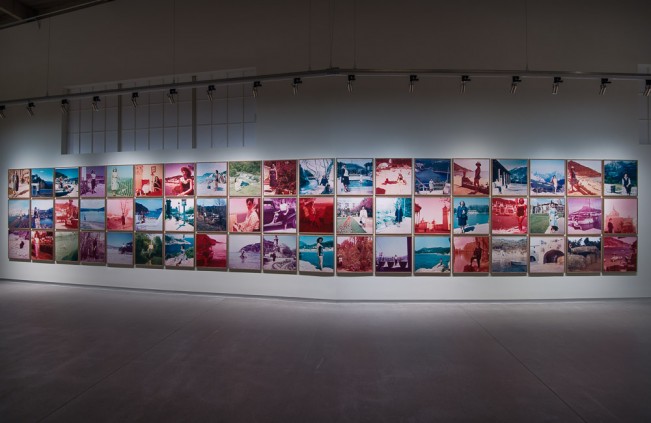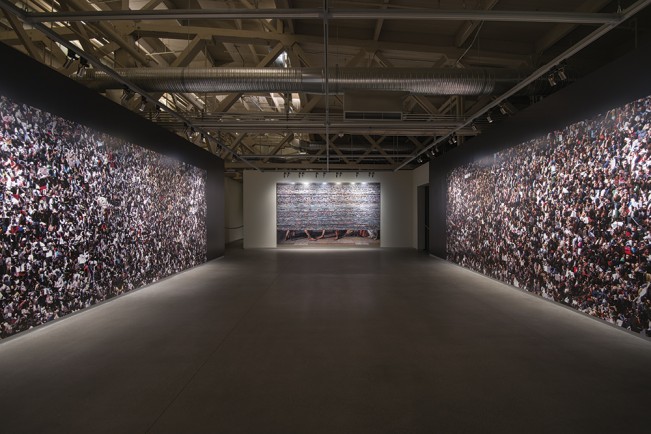Secondhand at Pier 24 Photography
 For the past several years, I’ve been hearing the buzz about PIER 24 Photography, an amazing space for photography located atop a pier in San Francisco. It hosts rotating exhibitions and houses the incredible Pilara Foundation Collection. About a month ago, I had the wonderful opportunity to visit the new exhibition, Secondhand at PIER 24 and was truly transformed by the experience. If I had to choose a favorite exhibition of 2014, Secondhand would be, hands down, number one on my list.
For the past several years, I’ve been hearing the buzz about PIER 24 Photography, an amazing space for photography located atop a pier in San Francisco. It hosts rotating exhibitions and houses the incredible Pilara Foundation Collection. About a month ago, I had the wonderful opportunity to visit the new exhibition, Secondhand at PIER 24 and was truly transformed by the experience. If I had to choose a favorite exhibition of 2014, Secondhand would be, hands down, number one on my list.
I wandered the almost twenty-gallery space, each room uniquely envisioned and curated, bringing remarkable levels of creativity, intelligence, and seeing, where works are not only exhibited in the most inventive way, but the considerations of pairings, framing, and simply the scope of the vision is unsurpassed. I felt completely energized by the experience and have thought about it at least once a day since walking in the front door.
Secondhand is the sixth exhibition at PIER 24 and it “features artists who build repositories of found images, from which they appropriate, construct, edit, and sequence in order to create something entirely new. Through this process, their distinctly personal approaches become as wide-ranging as their source material. These works are paired with selected vernacular photographs from the Pilara Foundation collection, illustrating another instance in which found pictures can offer new meaning through a simple change of context.” Something to be aware of, visitors are required to make appointments in advance. These appointments, which allow for an uncrowded, meditative viewing experience, can be secured for free online at www.pier24.org.

Pier 24 Photography located underneath the Bay Bridge, Courtesy of Pier 24 Photography, San Francisco

Pier 24 Photography located underneath the Bay Bridge, Courtesy of Pier 24 Photography, San Francisco
The exhibition makes the viewer examine several ideas about photography–the first, that photographers/artists have the impulse to curate–not only in their own work, but in the work they collect, and secondly, that found imagery, removed from the original context, offers new insights into interpreting that those photographs and allow us to “reexamine their relationship to commonplace imagery, while also considering the notion of authorship.”
Dutch artist, art director and collector Erik Kessels has work is featured in several large galleries. His collections “epitomize the fluidity of the roles of curator and creator. Kessels has amassed an immense archive of vernacular snapshots and photo albums that he incorporates into his artistic practice.” In Album Beauty and in almost every picture he curates from his holdings to suggest universal connections between found images, which, as a result, transcend their personal subject matter. Viewed through his lens, Kessels’s selections speak to the human experience and nod to the power, beauty, and materiality of these amateur pictures at a time when images are largely consumed online.
The curation and presentation of these rooms was beyond inspiring. Photographic scrapbooks were scanned and made into wall paper. Framed photographs were placed into empty windows of the wall sized scrapbooks and large photos lay stacked against the wall as if ready to be placed in the albums. Stacks of old photo albums were placed around the room. (see below)
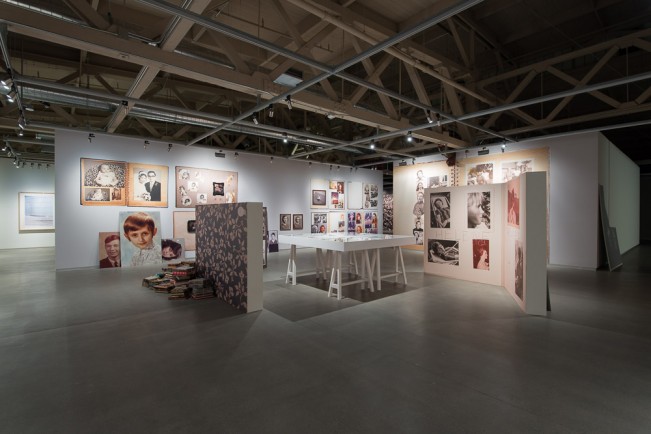
Erik Kessels, Album Beauty, 2012 [Installation view 2014, Pier 24 Photography] Courtesy Pier 24 Photography, San Francisco

Erik Kessels, Album Beauty, 2012 [Installation view 2014, Pier 24 Photography], Courtesy Pier 24 Photography, San Francisco
Other rooms featured Kessel’s collections of venacular photographs, each featuring one (or two) subjects photographed over time. The presentations reflect the power of documentation over time.

Erik Kessels, installation view featuring in almost every picture, 2002–10, and Photo Cubes, 2007, 2014 Courtesy Pier 24 Photography, San Francisco
Rooms painted in royal purple hold collections of imagery from the London based Archive of Modern Conflict. These rooms feature photographs from 1858 – 2012. “The photographs in Archive now span a wide range of genres and locations. There are images from just about everywhere, and examining the planet as a whole”

Archive of Modern Conflict, Collected Shadows, 2012, 2014 Courtesy Pier 24 Photography, San Francisco

Archive of Modern Conflict, Collected Shadows, 2012, 2014 Courtesy Pier 24 Photography, San Francisco

Archive of Modern Conflict, Collected Shadows, 2012, 2014 Courtesy Pier 24 Photography, San Francisco
Other rooms featured work where found photographs take on new incarnations through artistic reconstruction.

Joachim Schmid, Installation view at Pier 24 Photography, 2014 Courtesy the artist Courtesy Pier 24 Photography, San Francisco
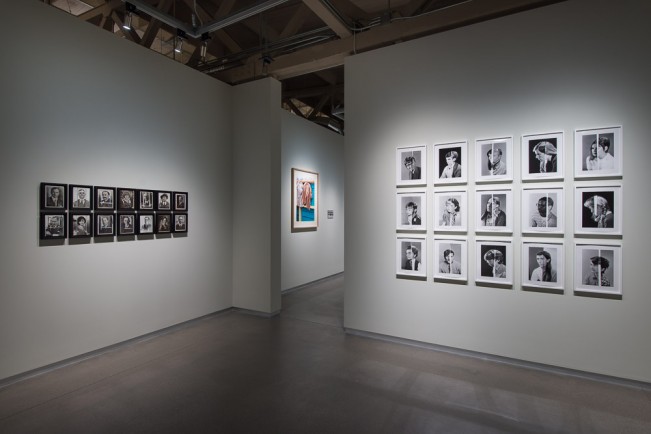
Joachim Schmid, Installation view at Pier 24 Photography, 2014 Courtesy the artist Courtesy Pier 24 Photography, San Francisco

Maurizio Anzeri, Installation view at Pier 24 Photography, 2014 Courtesy the artist Courtesy Pier 24 Photography, San Francisco
This idea for hanging images is quite amazing. Take for example, Melissa Catanese’s project Dive Dark Dream Slow. Here we find no shelf, these are just frames touching each other. The project, which was originally presented in book form, is installed at Pier 24 in the exact sequence of the book, allowing single-page book spreads to be represented on the wall with a single image and double-page spreads in the book are represented with images installed side-by-side. It was such a great way to organize smaller work giving it power and presence, while also maintaining the integrity of the original sequencing in the book.

Melissa Catanese, Installation view at Pier 24 Photography, 2014 Courtesy Pier 24 Photography, San Francisco
Historical objects, such as embroidered postcards (1910 -1920s), employee badges, (1920s – 1960s), and press photos (1910s – 1940s), which could be considered banal take on new interest when collected, curated, and put into new context.
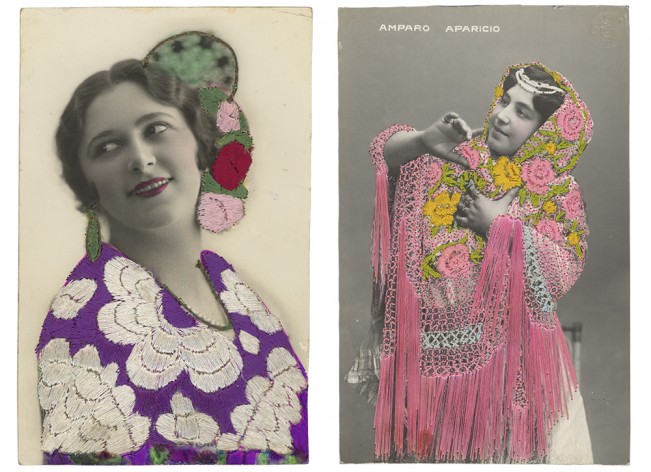
Unknown photographers, Embroidered postcards, 1910s–1942, 2014 Courtesy Pier 24 Photography, San Francisco
Rashid Rana “blends thousands of online images of unrest and protest to create an overwhelming crowd scene that engulfs the viewer”.
Erik Kessels project, 24 Hrs in Photos, “comments directly on the photograph’s role in the digital world. He printed every picture that had been uploaded over the course of one day to the photo-sharing website Flickr. Through this installation, the viewer can both visually and physically experience the overwhelming number of photographs shared online”.
Needless to say, this is an exhibition not to be missed and this post does not begin to do it justice. Secondhand may be viewed through May 2015 at Pier 24 Photography in San Francisco. And, a full printed guide to the exhibition may be purchased at SpacesCorners.com
Visit Pier 24 Photography: http://www.pier24.org/
Secondhand exhibition guide: http://www.spacescorners.com/
Posts on Lenscratch may not be reproduced without the permission of the Lenscratch staff and the photographer.
Recommended
-
Spotlight on the Photographic Arts Council Los AngelesNovember 23rd, 2025
-
100 Years of the Photobooth: Celebrating Vintage Analog PhotoboothsNovember 12th, 2025
-
100 Years of the Photobooth: The Photobooth Technicians ProjectNovember 11th, 2025
-
100 Years of the Photobooth: Rafael Hortala-Vallve: AUTOFOTONovember 10th, 2025
-
BEYOND THE PHOTOGRAPH: Q&A WITH PHOTO EDITOR JESSIE WENDER, THE NEW YORK TIMESAugust 22nd, 2025


